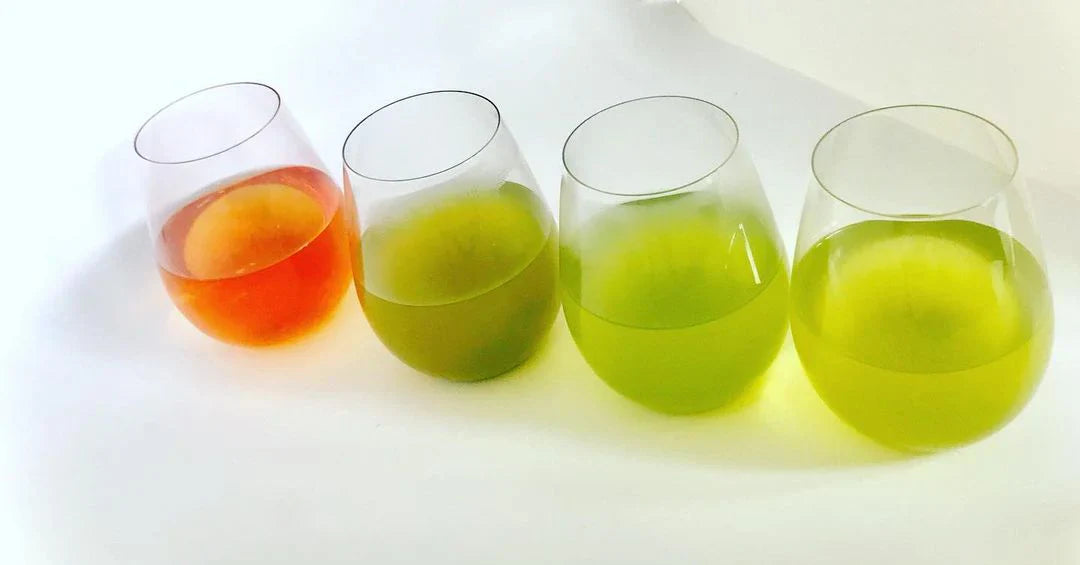
Discover the Different Types of Japanese Green Tea 🍃
In Japan, “Green Tea” (Ryokucha) is more commonly referred to as simply “Tea” (Ocha) or even “Japanese Tea” (Nihoncha). The distinctions between the many varieties of Japanese tea come down to two things: the quality of the tea plant used, and the way the leaves are processed. Within these broad categories, there are significant variations in flavour, aroma, price, and quality.
Some of the best Japanese teas hail from the Kakegawa region in Shizuoka, the Uji region in Kyoto, and of course, Yame region in Fukuoka, where our own Yamaguchien family farm has been cultivating tea for generations.
At Yamaguchien, we’re passionate about bringing you the very best of Japan’s green tea heritage. Here’s a guide to the most popular and distinctive types of Japanese green tea, from everyday favorites to rare, ceremonial brews.
 |
Sencha (煎茶) – The Everyday FavouriteSencha is the most widely enjoyed green tea in Japan. After harvesting, the leaves are steamed, rolled, and dried, preserving their natural green color and fresh aroma. What it is: The most commonly consumed green tea in Japan. Flavor: Light, grassy, slightly sweet with a refreshing finish. When to enjoy it: Perfect for everyday sipping, after meals, or as an afternoon pick-me-up. Brewing tip: Steep at around 70–80°C for 1–2 minutes to avoid bitterness. |
 |
Gyokuro (玉露) – The Shaded JewelOne of the most premium Japanese teas, Gyokuro is shaded from the sun for 20 days before harvest. This increases its chlorophyll and L-theanine content, resulting in a distinct umami taste. What it is: A premium tea grown under shade for 2–3 weeks before harvest, increasing amino acids like L-theanine. Flavor: Rich, umami-packed, with a sweet and smooth finish. When to enjoy it: On special occasions or when you want to indulge in something luxurious. Brewing tip: Use lower water temperature (50–60°C) and steep longer to extract its deep umami. |
 |
Matcha (抹茶) – The Ceremonial StarMatcha is a vibrant green powdered tea made from shade-grown leaves. Unlike other teas, you’re drinking the whole leaf, making Matcha rich in antioxidants and nutrients. What it is: Finely ground powder made from shade-grown tea leaves (often from the same plants as Gyokuro). Flavour: Creamy, bold, grassy, with a touch of bitterness. When to enjoy it: In traditional tea ceremonies, lattes, desserts, or daily rituals. Preparation tip: Whisk with hot water (80°C) in a “W” motion using a bamboo whisk (chasen) for a smooth froth. |
 |
Genmaicha (玄米茶) – The Popcorn TeaGenmaicha combines green tea (usually Sencha or Bancha) with toasted brown rice, creating a warm, nutty flavour with less caffeine. What it is: A mix of Sencha and roasted brown rice. Flavour: Nutty, toasty, comforting, with low bitterness. When to enjoy it: Great for beginners or as a calming evening tea. Fun fact: Originally popular among common folk as an affordable tea, it’s now loved worldwide. |
 |
Hojicha (ほうじ茶) – The Roasted WonderHojicha is made by roasting green tea leaves, often from Bancha or Sencha. This gives the tea a reddish-brown hue and a naturally low caffeine level. What it is: Roasted green tea (usually Bancha or Sencha), giving it a reddish-brown color. Flavour: Smoky, warm, slightly caramel-like with minimal caffeine. When to enjoy it: After dinner or before bed—soothing and easy on the stomach. Brewing tip: Use boiling water and steep for 30 seconds to 1 minute. |
Which One Will You Try Next?
Every green tea tells a story- from the careful cultivation of Gyokuro to the rustic charm of Genmaicha. At Yamaguchien Australia, we’re proud to bring you authentic Japanese teas, carefully sourced from our family-run farm in Fukuoka.
🛒 Explore our collection of green teas and find your favorite today.

